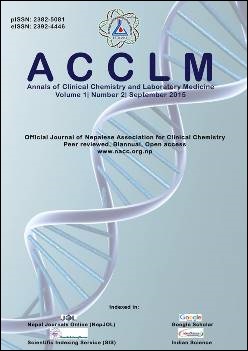High Prevalence of Extended-Spectrum Beta-Lactamase-Producing Respiratory Bacterial Pathogens in a Nepalese University Hospital: A Vexatious Problem
DOI:
https://doi.org/10.3126/acclm.v1i2.13047Keywords:
Antimicrobial resistance, ESBL, Respiratory pathogensAbstract
BACKGROUND: Extended-spectrum beta-lactamase (ESBL)-producing bacteria have resulted in vexatious problem to combat lower respiratory tract infection (LRTI). However, no detailed studies have been done in Nepal exploring the status of such pathogens from LRTI. Therefore, this study was carried out to assess the current levels of antimicrobial resistance with special reference to ESBL-producing respiratory bacterial pathogens in Nepal.
METHODS: A prospective study was conducted at Tribhuvan University Teaching Hospital in the capital city of Nepal. Specimens representing lower respiratory tract were received from 1120 patients suspected of LRTI. The specimens were collected and processed according to standard methodology. Combination disk (CD) and disk synergy test (DST) methods were used for the detection of ESBL-producing isolates.
RESULTS: Of the total 314 isolates belonging to Enterobacteriaceae and nonfermentative bacteria, 24.2% were ESBL-producers which included 42.2% of Klebsiella pneumoniae, 8.8% of Pseudomonas species, 41.9% of Escherichia coli, 12.9% of Acinetobacter species, 13.3% of Citrobacter species and 66.7% of Morganella morganii. ESBL-producers were more common among hospitalized patients. For ESBL-producers, the most effective drug was found to be imipenem, meropenem, followed by cefoperazone-sulbactam and amikacin.
CONCLUSIONS: One-fourth of the isolates belonging to Enterobacteriaceae and non-fermentative bacteria were ESBL-producer. It is quite essential to have effective antimicrobial and infection control policy in the hospital and special steps should be taken to prevent clonal dissemination of the resistant strains. Further studies should be done in other hospitals of Nepal to know the phenotype and genotype of ESBL-producing isolates prevailing in our country.
Downloads
Downloads
Published
How to Cite
Issue
Section
License
Authors who publish with this journal agree to the following terms:
- The author transfers copyright to the Nepalese Association for Clinical Chemistry.
- The journal publishes the work under a Creative Commons Attribution License that allows others to share the work with an acknowledgement of the work's authorship and initial publication in this journal and under the same share-alike license used here.
- Authors are able to enter into separate, additional contractual arrangements for the non-exclusive distribution of the journal's published version of the work (e.g., post it to an institutional repository or publish it in a book), with an acknowledgement of its initial publication in this journal.
- Authors are permitted and encouraged to post their work online (e.g., in institutional repositories or on their website) prior to and during the submission process, as it can lead to productive exchanges, as well as earlier and greater citation of published work (See The Effect of Open Access).




